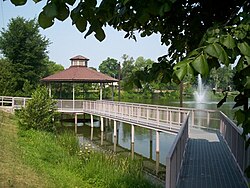Tillsonburg, Ontario
| Tillsonburg | |
|---|---|
| Town (lower-tier) | |
| Town of Tillsonburg | |
 |
|
| Motto: A Place to Build Your Future | |
| Coordinates: 42°52′00″N 80°44′00″W / 42.86667°N 80.73333°WCoordinates: 42°52′00″N 80°44′00″W / 42.86667°N 80.73333°W | |
| Country | Canada |
| Province | Ontario |
| County | Oxford |
| Settled | 1825 (as village) |
| Incorporated | 1872 (as town) |
| Government | |
| • Governing Body | Tillsonburg Town Council |
| • Town Mayor | Stephen Molnar |
| • Deputy Mayor | Dave Beres |
| • Councillors |
List of councillors
|
| Area | |
| • Land | 22.34 km2 (8.63 sq mi) |
| Elevation | 270 m (890 ft) |
| Population (2011) | |
| • Total | 15,301 |
| • Density | 685.1/km2 (1,774/sq mi) |
| • Demonym | Tillsonburger |
| Time zone | EST (UTC-5) |
| • Summer (DST) | EDT (UTC-4) |
| Postal code | N4G |
| Area code(s) | 519 and 226 |
| Website | www.tillsonburg.ca |
Tillsonburg is a town in Oxford County, Ontario, Canada with a population of 15,301 located about 50 kilometres southeast of London, on Highway 3 at the junction of Highway 19 the closest route to Highway 401 at Ingersoll, Ontario.
The area was settled in 1825 by George Tillson and other immigrants from Enfield, Massachusetts. A forge and sawmill were erected and roads built which led to the establishment of this small community, originally called Dereham Forge. The settlement was on the Big Otter Creek.
In 1836 the village was renamed Tillsonburg in honour of its founder. It was also in this year that the main street, Broadway, was laid out to its full 100-foot (30 m) width. Because the village was predominantly a logging and wood product centre, the street was built to accommodate the turning of three-team logging wagons. This width is now unique to Ontario and has become a benefit toward handling the pressures of modern-day traffic by providing angled parking. The extension of Broadway north was called Plank Line and is now known as Highway 19.
The mid-19th century proved to be the first step in the industrialization of this municipality. A water system was devised to not only supply pure water for domestic use, but also to provide water power to such industries as a sawmill, planing mill, grist mill, spinning mill, pottery and a tannery. Many of these new establishments were either owned, started, or financed by George Tillson.
1872 witnessed the incorporation of the village as the Town of Tillsonburg, with Edwin Delevan Tillson elected as its first Mayor. The Town of Tillsonburg reached a population of 2,000 in 1885, experienced its first church dedication, and had its first telephone installation established. Electric power was first utilized in 1912 and automobiles began to appear on the market.
In 1915, a Public Library was built with funds provided by the Carnegie Foundation, and the town's Memorial Hospital came into existence in 1925.
...
Wikipedia

